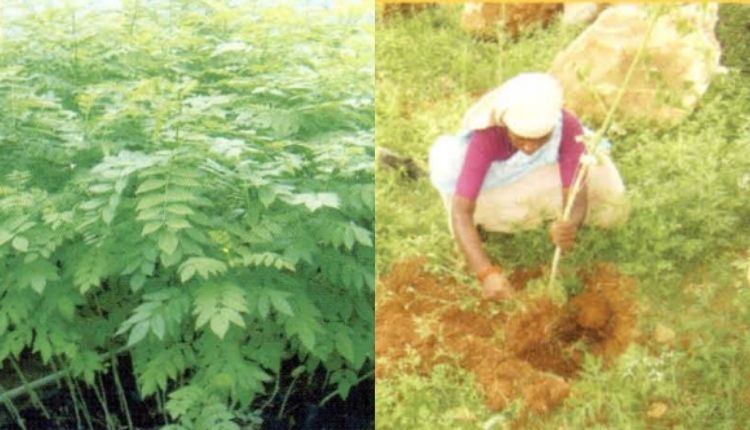Gliricidia: Increase soil potential with green leaf manure
Unmatched for long-term soil nutrition, Gliricidia grows in all soils and climates, producing green manure.
The continuous decline in soil fertility is the biggest challenge of Indian agriculture. Around 37 percent of the country’s land area, i.e., about 120 million hectares is affected by the poor soil problem. Unbalanced use of fertilizers and manure is the core cause of loss of soil fertility.
The fertility of the soil is directly related to the prosperity of farmers. It affects both the productivity and income of farmers. Eventually, they give up on improving soil fertility and this leads to an increase in barren land.Therefore, it is extremely important to take long-term measures for soil nutrition. Cultivation of green leaf compost ‘Gliricidia’ is one such impactful scientific method. It can be grown in all types of soil and environment.
Great way to nourish the soil
According to experts of ICAR-Indian Institute of Soil Science, Bhopal, there is a gap of about 10 million tonnes in the demand and supply of nutrients for the soil in our country. However, a number of measures exist to check the declinein soil fertility and produce sustainable crops.
GliricidiaSepium is the most promising and climate-friendly option. It is a medium-sized, semi-deciduous, fast-growing multipurpose plant grown in many parts of Central America, Mexico, West Africa, the West Indies and South Asia to provide rich soil nutrition.
Green manure, fodder and fuel are also obtained from Gliricidia. It is also used to prepare biochar (pyrolyzed biomass).

The source of organic nitrogen is Gliricidia
Gliricidia provides nitrogen to plants by forming a symbiotic relationship with rhizobia through their root knots. In this way, atmospheric nitrogen is fixed by gliricidia. Through a scientific method called isotope dilution, it has been found that in a single cropping system, Gliricidiaprovides 70 to 274 kg per hectare per year of nitrogen to the soil.
Application of this green leaf manureleads to sustainable improvement in soil fertility and higher yields of crops such as maize, gram, millet, and tur.It has been noted that with the usage of organic fertilizer at the rate of 20 kg per hectare, the yield of maize increases by 1.7 to 2.1 tonnes per hectare.
Gliricidia also plays an important role in crop rotation and intensive cropping systems. It can be grown in any type of soil and climate. It is especially beneficial for rainfed cropping systems, i.e., rainfed farming.
Therefore, farmers are advised to plant gliricidia on the farm-pond bunds. The use of Gliricidia as green leaf manure along with chemical fertilizers can improve the biological properties of the weeds promoting soil fertility.
Gliricidia are vigorous green manures
About 21 kg of nitrogen, 2.5 kg of phosphorus, 18 kg of potassium, 85 grams of zinc, 164 grams of manganese, 365 grams of copper and 728 grams of iron are available from one tonne of Gliricidia green leaf manure. Apart from this, it also provides a lot of elements like sulphur, calcium, magnesium, boron and molybdenum.
Microorganisms such as fungi, bacteria, actinomycetes, microbial biomass improve soil biological properties.
Adding glycericidia green leaf manure drastically improves the organic matter in the soil. Gliricidia have the ability to absorb carbon dioxide from the atmosphere and store it in the form of biomass. This provides about 33 tonnes per hectare of dry matter, which is equivalent to 14.6 tonnes of carbon. Its carbon sequestration rate is 0.91 tonnes per hectare per annum. It directly contributes to maintaining the organic carbon reserves of the soil.

How to Cultivate Gliricidia?
There are two methods of growing Gliricidia. Its stalk can be directly transplanted or its seeds can be sown. When the plant is to be prepared from the stem, its pen should be taken from the branch of a fully grown tree. The pen is cut diagonally at both ends. Then,a 20 to 50 cm long pen is buried in the soil. If Gliricidia is to be planted as a live fence in the field, then the length of the pen should be about one meter.
If gliricidia plants are to be grown from seed, the seeds should be soaked overnight in water for proper germination. In the nursery, soaked seed should be sown in a mixture of equal quantities of soil, sand and cow dung manure in plastic pouches and polythene bags. The bags should be watered regularly for proper moisture. After this, the plants should be transplanted in the rainy season on the farm-pond bund. For transplanting, 3 to 4 months’ old plants should be planted at a distance of 50 cm from each other. If gliricidia is to be planted on a slope, the spacing between plants should be 20 cm. This helps in preventing soil erosion.

Harvesting of Gliricidia
Gliricidia requires no special care. It should be pruned thrice a year for better soil nutrition. It needs to be cut from 75 cm above the ground. The first harvesting should be done before the sowing of Kharif, i.e., in June. Second harvesting can be done in November before Rabi sowing and the third harvesting can be done in March.
After pruning, the stems and leaves of gliricidia should be cut into small pieces and spread on top of the soil in the fields. In this way, the fields will get a dose of green manure before the new crop. The leaves of Gliricidia contain about 2.4% nitrogen, 0.1% phosphorus, 1.8% potassium, besides calcium and magnesium in abundance.
Contact details: If farmers want to share information or experiences related to farming with us, then they can do this by calling us on the phone number 9599273766 or by writing an email to kisanofindia.mail@gmail.com or by sending your recording. Through Kisan of India, we will convey your message to the people, because we believe that if the farmers are advanced then the country is happy.

